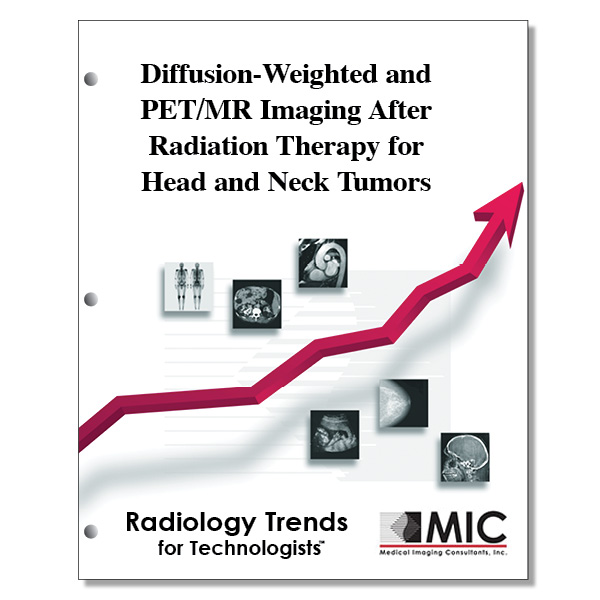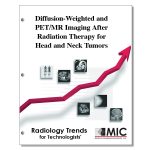

Diffusion-Weighted and PET/MR Imaging After Radiation Therapy for Head and Neck Tumors
This review focuses on clinical applications of DW and PET/MR imaging of the irradiated neck.
Course ID: Q00459 Category: Radiology Trends for Technologists Modalities: MRI, Nuclear Medicine, PET, Radiation Therapy3.0 |
Satisfaction Guarantee |
$34.00
- Targeted CE
- Outline
- Objectives
Targeted CE per ARRT’s Discipline, Category, and Subcategory classification:
[Note: Discipline-specific Targeted CE credits may be less than the total Category A credits approved for this course.]
Magnetic Resonance Imaging: 2.50
Patient Care: 0.25
Patient Interactions and Management: 0.25
Image Production: 0.75
Physical Principles of Image Formation: 0.50
Data Acquisition, Processing, and Storage: 0.25
Procedures: 1.50
Neurological: 1.50
Nuclear Medicine Technology: 0.50
Image Production: 0.50
Instrumentation: 0.50
Radiation Therapy: 0.50
Patient Care: 0.50
Patient and Medical Record Management: 0.50
Outline
- Introduction
- DW and PET/MR Imaging
- Hybrid PET/MR Imaging and Multimodality Image Fusion
- Key Findings at MR, DW, and PET/MR Imaging
- Expected Changes after Radiation Therapy
- Mucositis, Dermatitis, Soft-Tissue Edema, and Fibrosis
- Scar Tissue
- Sialadenitis and Xerostomia
- Replacement of Hemopoietic Marrow by Fatty Marrow and Activation after Chemotherapy
- Physiologic Functional and Metabolic Findings
- Complications after Radiation Therapy
- Soft-Tissue Necrosis and Granulation Tissue
- Osteoradionecrosis and Chondroradionecrosis
- Arteriopathy and Cerebrovascular Complications after Radiation Therapy
- Thyroid Disorders
- Radiation Therapy-induced Brain Necrosis
- Cranial Nerve Palsy
- Radiation Therapy-induced Tumors
- Treatment Failure and Recurrent Disease
- Expected Changes after Radiation Therapy
- Pitfalls
- Susceptibility Artifacts from Dental Hardware or Osteosynthesis Material
- Miscoregistration Artifacts
- Insufficient Scanner Resolution and Low FDG Avidity
- False-Positive Findings Due to Inflammatory and Infectious Diseases
- Incidentalomas
- Conclusion
Objectives
Upon completion of this course, students will:
- identify the cancer type that represents the vast majority of malignant head and neck tumors in adults
- list the particles used in external beam radiation therapy for head and neck tumors
- describe the currently preferred radiation therapy option for the head and neck
- identify the IMRT dose range delivered to high-risk areas
- list the imaging techniques that are routinely used in clinical practice to evaluate head and neck cancers
- describe pathologies that exhibit increased water diffusion on DW imaging
- explain the units of measurement of the apparent diffusion coefficient (ADC)
- understand the diagnostic capabilities of FDG PET/CT for detection of head and neck SCC
- recognize the value of FDG PET/CT in the evaluation of head and neck SCC
- list the pathologies that may demonstrate increased FDG uptake and lead to false-positive PET/CT image findings
- describe the mean SUV range of head and neck SCCs at FDG PET/CT imaging
- list the hybrid imaging system design that uses MR imaging-based attenuation correction maps to calculate SUVs
- compare the SUVs of focal lesions calculated at PET/MR with those calculated at PET/CT
- describe the timing of early effects of high-dose radiation therapy
- list the tissue types that typically demonstrate late effects of irradiation
- list the late effects of radiation therapy
- list the areas affected by radiation therapy-induced superficial lymphedema
- describe the tissue features present in a mature scar
- identify the imaging features that occur in the presence of scar tissue
- define the imaging feature known as “evil gray”
- list the body areas that may demonstrate high physiologic nonspecific FDG uptake
- describe atypical locations of brown fat
- recognize the diagnostic technique used to detect local mucosal destruction
- describe the imaging characteristics of soft-tissue necrosis following administration of gadolinium contrast agents
- identify the diagnostic techniques recommended for correlation with morphologic imaging when differentiating recurrent disease from benign soft-tissue necrosis
- understand the time frame for the occurrence of osteoradionecrosis after radiation therapy
- recognize the increased risk for osteoradionecrosis associated with radiation therapy doses of 62-70 Gy
- list the most reliable imaging signs of osteoradionecrosis
- describe the percentage of patients who may demonstrate chondroradionecrosis with recurrent tumor
- recognize the most common manifestation of radiation therapy-induced arteriopathy in the head and neck
- understand the effect of radiation therapy in the risk for development of thyroid disorders
- identify the brain region typically involved with radiation therapy-induced brain necrosis
- list the predisposing factors for radiation therapy-induced optic neuropathy
- list the pathologies that may lead to radiation therapy-induced tumors in the head and neck
- describe the imaging techniques that have limited value for precise assessment of deep tumor spread in the irradiated neck
- identify the diagnostic technique that may be superior to PET/CT, CECT, and MR imaging for detection of small metastatic nodes
- describe the diagnostic capabilities of FDG PET when investigating recurrent tumors and nodes after radiation therapy
- understand the impact of the positive predictive value of PET/CT in the evaluation of recurrent tumors
- list the areas where second primary tumors in patients with head and neck SCC recurrence are most often detected
- define miscoregistration due to geometric distortion
- describe the parameters of PET reconstructions in the head and neck
- list the imaging findings of peritumoral inflammation
- describe the percentage of thyroid incidentalomas that can be malignant
- identify the pathologic condition that exhibits very low signal intensity on both T1- and T2-weighted MR images
- identify the pathologic condition that demonstrates low ADCs
